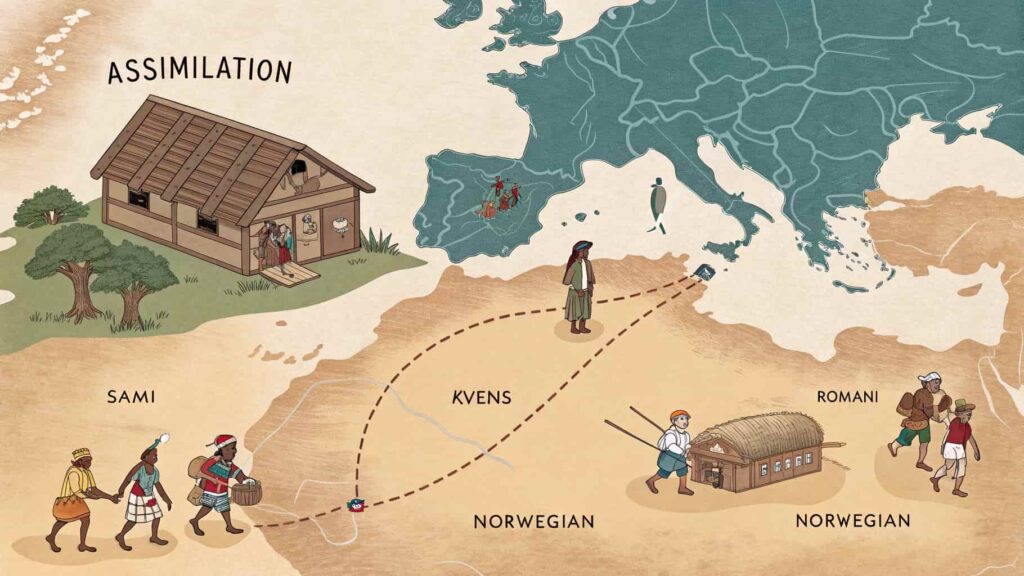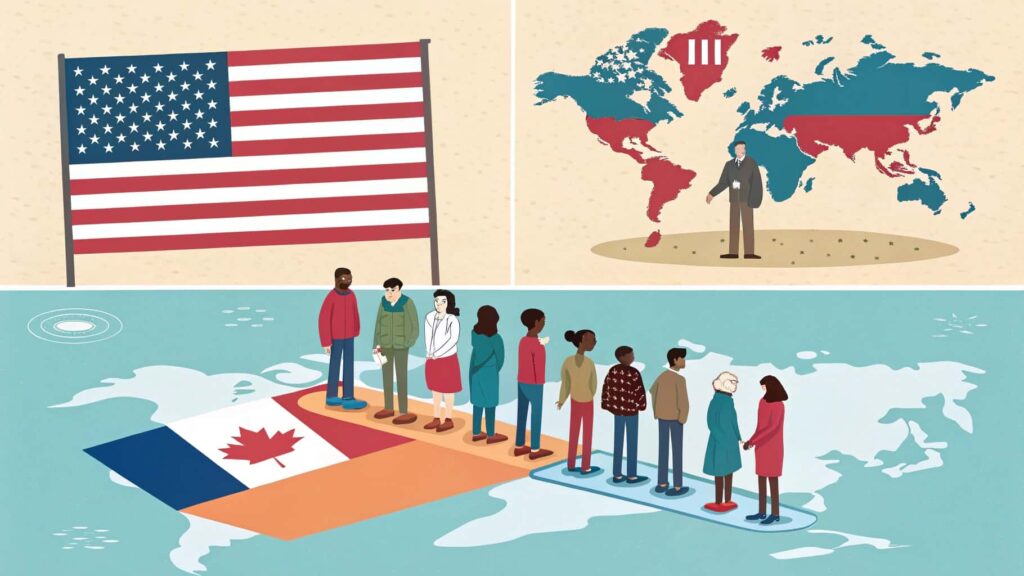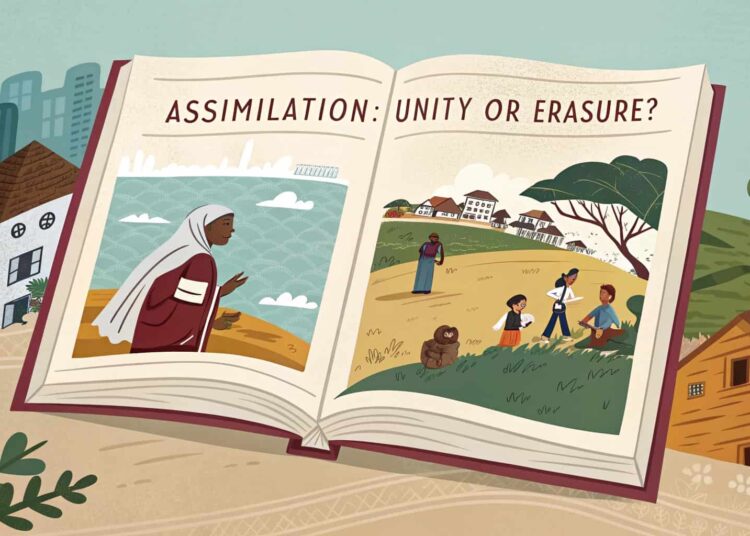Assimilation is a powerful and complex term used in social science, cultural studies, migration discussions, and politics. It describes a process that affects identity, belonging, and cultural survival. Depending on the context, assimilation can be viewed as either a path to unity or a form of cultural erasure.
This article provides a deep and well-balanced exploration of assimilation, its history, types, pros and cons, and relevance in today’s globalized world.
What Is Assimilation?
Assimilation is the process by which individuals or groups adopt the culture, language, values, and norms of another group—usually the dominant or majority culture. Over time, the original cultural traits of the minority group may be lost or diminished.
Examples of assimilation include:
- Immigrants abandoning their native language to speak only the dominant language.
- Indigenous people being forced to adopt the religion and lifestyle of colonial powers.
- Minority children growing up in a society where they adopt the customs and identity of the mainstream culture.
The Historical Roots of Assimilation

Assimilation in Colonial Times
During the colonial period, assimilation was a central tool used by European empires to dominate colonized populations. Indigenous cultures in Africa, Asia, and the Americas were suppressed as colonial powers attempted to impose European languages, religions, and social structures.
In French colonies, assimilation was an official policy. Indigenous people were expected to adopt the French language and customs to be accepted as “civilized.”
Assimilation in the Nordic Region
In Norway and other Scandinavian countries, assimilation was directed at indigenous groups like the Sámi, Kvens, and Romani people. From the 1800s to the 1900s, Norwegian authorities enforced policies that pressured these communities to speak Norwegian and live according to Norwegian customs. This process is known as “fornorsking” or Norwegianization, and it caused significant cultural loss.
Assimilation vs. Integration
Though often confused, assimilation and integration are different concepts.
| Feature | Assimilation | Integration |
| Cultural Outcome | Minority adopts dominant culture fully | Minority retains its culture |
| Language Use | One language expected (dominant) | Multilingualism accepted |
| Identity Expectation | Single national identity | Multiple identities accepted |
| Diversity Value | Reduced or erased | Preserved and respected |
Assimilation demands uniformity, while integration promotes coexistence and mutual respect.
Types of Assimilation
Assimilation can take various forms, some voluntary and others forced.
1. Cultural Assimilation
This occurs when a group adopts the customs, traditions, and lifestyle of the majority culture. It can be voluntary—such as adopting holidays or dress codes—or due to societal pressure.
2. Linguistic Assimilation
When minority languages disappear as people shift to speaking only the dominant language. This is common among second-generation immigrants who often do not speak their parents’ native language.
3. Social and Political Assimilation
This refers to active participation in mainstream institutions like voting, public service, and labor unions—often accompanied by aligning with dominant social norms.
4. Psychological Assimilation
Here, individuals emotionally and mentally identify more with the majority culture and may distance themselves from their roots.
Also read:Tortellinatrice
What Drives Assimilation?
Several factors can contribute to assimilation:
- Societal Pressure: Discrimination or lack of acceptance often pushes minorities to “fit in.”
- Education Systems: When schools teach only in the dominant language, it promotes linguistic assimilation.
- Media Influence: TV, movies, and social media spread dominant cultural norms quickly.
- Urbanization: Diverse people living closely together in cities often accelerate assimilation.
- State Policies: Some countries implement policies that push people toward uniform national identities.
Benefits and Downsides of Assimilation
Potential Benefits
- Common Ground: Shared language and values can foster unity.
- Improved Access: Assimilated individuals may face fewer barriers in education or employment.
- Social Cohesion: A unified cultural identity may support national solidarity.
Serious Disadvantages
- Loss of Identity: Assimilation can lead to the erasure of languages, traditions, and worldviews.
- Mental Health Struggles: People who feel torn between identities may experience anxiety or isolation.
- Cultural Homogenization: A society may lose its diversity, richness, and innovation.
Assimilation in Modern-Day Norway
Norway today is a multicultural country. Debates around assimilation continue, especially regarding immigration, religion, and national identity.
Some political voices argue that immigrants must “become like Norwegians.” Others advocate for a diverse society where cultures coexist and enrich one another.
There is also an ongoing reckoning with the history of forced assimilation directed at the Sámi and other minorities, with efforts to revitalize languages and cultures that were nearly lost.
Global Perspectives on Assimilation

United States
Often described as a “melting pot,” the U.S. has historically encouraged assimilation. Immigrants were expected to learn English and adopt American values. However, this model has been criticized, especially considering the historical assimilation pressures placed on African Americans, Native Americans, and other marginalized groups.
Canada
Canada follows an official multiculturalism policy, which supports the retention of immigrant languages and cultures. This is a deliberate contrast to the American and French models of assimilation.
France
France emphasizes universal republican values and often downplays ethnic and cultural differences. Its assimilationist approach has led to criticism, particularly regarding its treatment of Muslims, North African immigrants, and religious expression.
Assimilation and Identity
At its core, assimilation is about identity. It affects how people see themselves, where they feel they belong, and how they are treated by society.
Important questions include:
- Do I have to change who I am to be accepted?
- Is my culture seen as inferior or unimportant?
- Can I embrace both my heritage and my current surroundings?
Assimilation can create identity conflicts, especially in children who grow up between two cultures. They may feel they don’t fully belong in either.
Also read: Peekskill USA
Digital Age and Cultural Preservation
The digital world offers new tools to resist cultural erasure. Social media platforms, YouTube, and podcasts allow people to share, teach, and preserve their culture and language.
Technology also enables diaspora communities to stay connected to their roots—even as they adapt to new societies.
Rather than forcing assimilation, today’s world encourages cultural hybridity—where people blend influences in unique and creative ways.
SEO-Friendly Subtopics for “Assimilation”
To optimize for the keyword assimilation, you can create additional content around the following subtopics:
- Assimilation in education systems
- Forced vs. voluntary assimilation
- Effects of assimilation on youth
- Assimilation of indigenous groups
- Historical assimilation in Europe
- Assimilation vs. multiculturalism
- Role of language in assimilation
- Psychological effects of assimilation
- Immigration and assimilation policies
- The future of assimilation in globalized societies
Conclusion:
Assimilation is a multidimensional process that influences language, identity, politics, and social cohesion. While it may offer some advantages, such as unity and simplicity, it often comes at the cost of cultural diversity and personal authenticity.
In an interconnected world, the ideal is not forced assimilation but mutual respect. Societies thrive when individuals are allowed to express their identities without being forced to abandon their roots.
Frequently Asked Questions
1. What is assimilation?
Assimilation is the process where a person or group adopts the cultural traits of another group, often leading to the loss of their original culture.
2. Is assimilation always negative?
No. Assimilation can be voluntary and even empowering, but when it’s forced or expected, it can harm individual identity and cultural diversity.
3. How does assimilation differ from integration?
Assimilation demands that minorities adopt the dominant culture completely. Integration allows minorities to retain their culture while participating in society.
4. What are some examples of assimilation?
Examples include indigenous children being placed in boarding schools, immigrants adopting the dominant language, or minority customs being banned.
5. Why is assimilation controversial?
It often involves power imbalances and can result in the suppression of minority cultures, which is viewed as a violation of human rights.
6. Can people be psychologically affected by assimilation?
Yes. People may feel alienated, lose their sense of self, or struggle with identity confusion, especially in cases of forced assimilation.
7. What is linguistic assimilation?
This occurs when people stop using their native language in favor of the dominant one, often due to education systems, societal pressure, or migration.
8. Has assimilation affected indigenous groups?
Yes. Many indigenous groups worldwide have lost languages, customs, and land due to historical assimilation policies.
9. Is assimilation still happening today?
Yes. While often less explicit, many societies still reward conformity and discourage visible cultural difference, especially in schools or workplaces.
10. How can we promote cultural diversity instead of assimilation?
By supporting bilingual education, celebrating multiculturalism, ensuring equal rights, and recognizing the value of all cultural heritages.
Related post:















